| Reviews & Columns |
|
Reviews DVD TV on DVD Blu-ray 4K UHD International DVDs In Theaters Reviews by Studio Video Games Features Collector Series DVDs Easter Egg Database Interviews DVD Talk Radio Feature Articles Columns Anime Talk DVD Savant Horror DVDs The M.O.D. Squad Art House HD Talk Silent DVD
|
DVD Talk Forum |
|
|
| Resources |
|
DVD Price Search Customer Service #'s RCE Info Links |
|
Columns
|
|
|
Lady Vanishes - Criterion Collection, The
THE MOVIE:
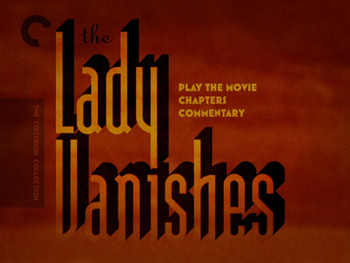
The term "popcorn movie" is generally applied to films that are entertainment at its most pure. The kind of movies that are full of twists and turns and we dare not look away as we scarf down our popcorn, stuffing our face with fluffy snacks while our eyes are stuffed with movie fun.
Alfred Hitchcock's 1938 British thriller The Lady Vanishes is definitely a popcorn movie. This tightly plotted lark is custom built for suspense. Its charms are simple and true, the very kind of movie folks mean when they say, "They don't make them like that anymore." Though the original Criterion DVD, released in 1998 as the third in their long-running series, has been out of print for some time, The Lady Vanishes has returned at last, spruced up with a new transfer and a second disc of bonus features.
The Lady Vanishes opens in an out-of-the-way European town. An avalanche has stranded a host of travelers at a mountain resort overnight. No trains can leave until morning when all of the snow is cleared. The first twenty-five minutes of Sidney Gilliat and Frank Launder's script stays put at the hotel. Hitchcock and his writers are taking their time setting everything up, creating a false sense of security as they introduce the various characters that will become important once the mystery is underway.
Amongst the stranded are Charters and Caldicott (Basil Radford and Naunton Wayne), two cricket-obsessed Englishmen trying to get back to Manchester in time to catch the last match of the season. Also hailing from the British isles is a loving couple (Cecil Parker and Linden Travers) who are married--just not to each other. Elsewhere, there is the spoiled socialite Iris (Margaret Lockwood), who throws her fiancée's money around like it was nothing, making sure she gets whatever she wants with plenty of well-placed bribes. This includes getting Gilbert (Michael Redgrave), a scholar with a yen for folk dancing, thrown out of his room because the dancing he's studying makes too much noise. The two bicker over the situation, but Gilbert's seen the world, he's dealt with the overly privileged before.
And, of course, there is Miss Froy (Dame May Whitty), the kindly governess ready to return home after six years of teaching music to mountain children. She is a kindly old lady, friendly to all, accepting of everything. While the rest of the cast trundle on chasing their own interests, Miss Froy enjoys the simple pleasures of life.
Not all is as it seems, however, and Hitchcock teases us with hints of darker doings. The serenading musician that Miss Froy enjoys under her window gets strangled, his attacker seen only as a sinister shadow. The next morning, when Miss Froy prepares to board the train, someone drops a planter on her. Only, they miss and clock Iris on the head instead. In its way, this mishap is convenient, because when Iris passes out while riding the rails, it gives everyone a convenient excuse to suggest that she's imagining things when she awakes to find Miss Froy gone. The Spanish couple in the travel car with her claim to have never seen an old English woman, as do the porters and everyone else on the train. Iris knows what she saw, but a respected doctor (Paul Lukas) also traveling on that line lends credence to the theory that the concussion has caused Iris to hallucinate. Only Gilbert is willing to listen to her, and that's just barely.
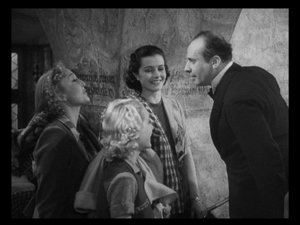
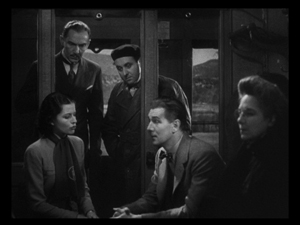
Once Miss Froy is gone, Hitchcock throws The Lady Vanishes into high gear. While he took his sweet time for the first third of the film, it was only to gather steam to really put the pedal to the metal when he started rolling out the thrills. Without the time spent with the other characters, the confusion stacking up around Iris wouldn't have made as much sense or had the same impact. We know that the lovers, for instance, are trying to keep a low profile, and so when Hitchcock has them lie about having seen Miss Froy, the audience is privy to their motives. It means we can believe in Iris, and her frustration is our frustration--perhaps even moreso, since we know how she's being duped.
At least to a degree. Hitchcock keeps the secret of Miss Froy's disappearance constantly out of reach. By the middle of the third act, I was almost convinced he was never going to tell us, and I wasn't sure that it would really matter. The sheer pleasure of The Lady Vanishes is how things continue to tumble down, piling on the obfuscation. The plot is like the avalanche that stranded everyone in the mountains: the more that falls, the more we have to stick with it. Each answered question brings up two more that are unanswered, and as viewers, we're so invested, we're not going anywhere until it's all sorted out.
As the engineer of this train ride, Hitchcock drives The Lady Vanishes with unparalleled glee. The old master took great delight in the silly things people do to preserve their own interests. A pulled shade means a great deal in a Hitchcock movie, because everyone has secrets they want to hide. This makes it all the more easy for the bad guys to keep the cover-up going. If everyone who could expose you is ducking out of the way so they aren't caught for something else, you're in the clear.
The Lady Vanishes is full of black humor and sly winks. Those winks are most evident in the relationship of Iris and Gilbert. Their meeting--her egocentric pouting, his caddish behavior--is a classic movie version of cupid's arrow. You just know these two are heading toward romance. He, of course, sees it long before she does. Why else would he hang around when there is so little evidence on her side? When his intentions do finally become clear, it's a wryly-humorous confession. How can Iris not swoon when Gilbert says he likes her because she reminds him of his father? Here I thought all boys wanted to marry their mother. What would Freud say?
Of course, Hitchcock is as much of a master of having fun with Freud as he is at creating suspense. There's a reason he puts this story on the rails. It's so that train can go through all those tunnels! Though, ironically, one of those times the tunnel not only keeps Gilbert from getting what he wants, but it erases the one clue Iris has managed to find to prove Miss Froy was really there. Surely Hitchcock isn't saying sex will only frustrate us and make us lose clarity?
Then again, such notions are part of the overall Maguffin of filmmaking. Details of this kind keep us entertained and looking in the wrong direction while Hitchcock pulls his tricks off to the other side. Thus, The Lady Vanishes keeps us riveted to the screen, oblivious to any implausibility, and ready to go wherever this locomotive takes us. As with Hitchcock's later and greatest work, it's the kind of movie that just gets more intriguing the more you watch it. Details give way to details, and the more you know, the more fun you have. Popcorn after bucket of popcorn, The Lady Vanishes never dulls.
THE DVD
Video:
The picture on The Lady Vanishes - Criterion Collection is in a 1.33:1 aspect ratio, full screen but "pictureboxed" so that there will be black bars on all four sides when viewed on a widescreen television. On standard square tubes, the picture will fill the entire screen.
This new transfer, spruced up for a hi-def world, is really nicely done. The image quality is crisp and largely free of glitches. Some scratches still surface, most obviously at the very beginning of the movie and one long line down the middle when the Nun (Catherine Lacy) first arrives. Still, for a movie that has had many dubious releases over the years, this is the best it has ever looked, and it's very close to perfect.
The old transfer from 1998 was actually pretty good, but taking just a short sampling of the old disc, I saw a lot more surface grit and much softer resolution without really having to look very hard for it. Though my screengrabs aren't perfectly timed, they are within a second or two of each other, and I think you will see how much softer the old version is right away. At first blush, the blacks here appear to be deeper in the earlier shot, but the detail we get under the table and behind Miss Froy's back could be argument that the previous transfer was too dark.
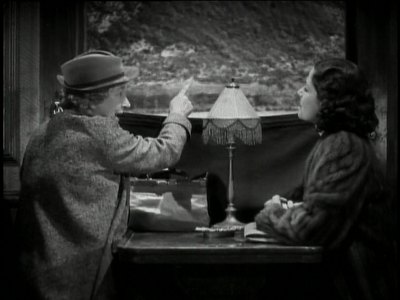
1998
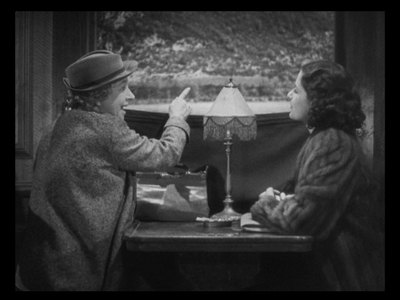
2007
Also, look at the edges of the frame on all four sides of each picture. While some of the "pictureboxed" transfers Criterion has done have been criticized for showing less of the original image, here you can see we're actually getting more.
Sound:
The mono mix of the original English soundtrack is a solid job, getting rid of any extraneous noise and maintaining the right quality to the sound that is intended to be here. The persistent train whistles have excellent pitch, loud without being tinny.
Extras:
The original Criterion DVD of The Lady Vanishes came with an audio commentary by film historian Bruce Eder as its sole extra. That commentary is retained here, and it and the film are the only things on DVD 1. Though that first release had an interior insert like all the Criterion discs, its essay by critic Michael Wilmington is gone; in its stead is an amply illustrated twenty-page book with credits, chapter listings, and two new essays by writers Geoffrey O'Brien and Charles Barr.
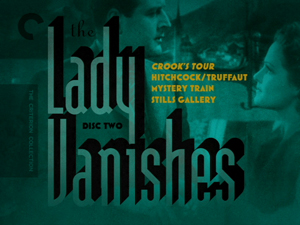
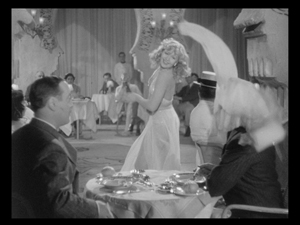
DVD 2 of The Lady Vanishes - Criterion Collection is all-new, bursting with bonus features to go with the main movie. The most surprising of these is Crook's Tour a eighty-minute film from 1941 that reunites Basil Radford and Naunton Wayne as their Lady Vanishes characters, the cricket fans Charters and Caldicott. Directed by John Baxter, who helmed forty-two pictures including the Old Mother Riley series, this B-grade film is more comedic than the Hitchcock flick and is set in Saudi Arabia and Baghdad, of all places, before moving on to other exotic locales. It's a mild diversion, definitely not in the same league as the movie it spun out of.
The other extras are about the production of The Lady Vanishes. The thirty-three minute video essay Mystery Train was put together by Hitchcock chronicler Leonard Leff. He speaks about the British film industry, the origins of The Lady Vanishes, its covert political message, and the particulars of the production over clips from the film and photos and posters from various aspects of Hitchcock's career. Photos and clips also illustrates ten-minutes of audio conversation between Alfred Hitchcock and Francois Truffaut about The Lady Vanishes, and many of the same pictures make up the image gallery that rounds out the disc.
FINAL THOUGHTS:
The new 2-disc reissue of The Lady Vanishes - Criterion Collection is Highly Recommended. A cleaner transfer and newer extras are all well and good, but as always the real draw is the Alfred Hitchcock thriller. A pleasure with no guilt, this fun picture has romance, wit, and action. The subtle details of character and situation means the mystery only gets more intriguing the more often you see it. You definitely want to upgrade on this one if you've got the 1998 single-disc version, and if you have yet to add The Lady Vanishes to your library, your patience will be rewarded.
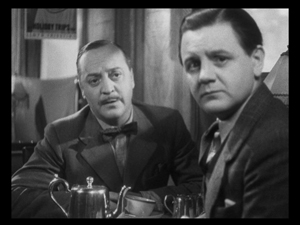
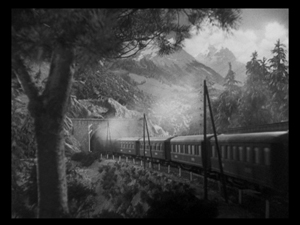
Jamie S. Rich is a novelist and comic book writer. He is best known for his collaborations with Joelle Jones, including the hardboiled crime comic book You Have Killed Me, the challenging romance 12 Reasons Why I Love Her, and the 2007 prose novel Have You Seen the Horizon Lately?, for which Jones did the cover. All three were published by Oni Press. His most recent projects include the futuristic romance A Boy and a Girl with Natalie Nourigat; Archer Coe and the Thousand Natural Shocks, a loopy crime tale drawn by Dan Christensen; and the horror miniseries Madame Frankenstein, a collaboration with Megan Levens. Follow Rich's blog at Confessions123.com.
|
| Popular Reviews |
| Sponsored Links |
|
|
| Sponsored Links |
|
|
| Release List | Reviews | Shop | Newsletter | Forum | DVD Giveaways | Blu-Ray | Advertise |
|
Copyright 2024 DVDTalk.com All Rights Reserved. Legal Info, Privacy Policy, Terms of Use,
Manage Preferences,
Your Privacy Choices | |||||||












